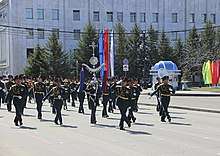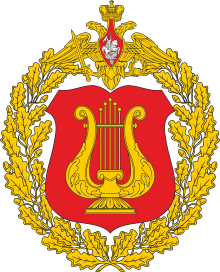Russian military bands
Russian military bands fall under the jurisdiction of the Military Band Service of the Armed Forces of Russia, which is the official music service for the Russian Armed Forces, and led by the Senior Director of Music, a billet of an officer with the rank of a Colonel or a general officer. There are currently between 200 and 300 military bands in the Russian Armed Forces that span across the military as well as all uniformed services in the country.[1][2] Unlike mostly western nations, the Armed Forces does not maintain any bands composed of volunteering civilian musicians, as all bands, active or reserve, are manned by graduates of the military music training centers stationed anywhere in the country, as well as of civilian conservatories. While choirs may be attached to military bands, individual staff choirs do not exist in the Russian Armed Forces, since they have attached instrumental ensembles or orchestras. As of 2009, all military musicians are paid around 13,000 rubles ($203.11) for their service in the Armed Forces.[3]
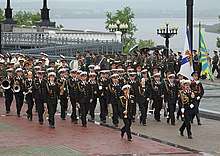
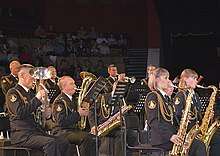
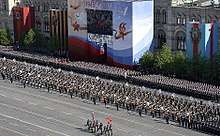
Purpose
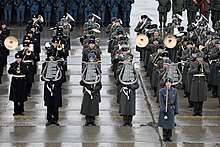
The military band service is designed to provide encouragement and to increase patriotism for the military servicemen and women of the Ground Forces, the Navy and the Aerospace Forces. Former director of bands in the Russian Armed Forces Valery Khalilov described the effect these bands have in the following 2005 interview:[1]
"Military music is incredibly important for Russians, because military music is a component of the Russian army, and the army has always played a crucially important role in protecting Russia’s great statehood and in making it a powerful nation."
Historically, in Russia and around the world, military bands have been used to facilitate commands to troops and lead armies into battle.
History
For a country that has not just one of the largest armed forces in the world but also has produced some of the greatest composers and musicians, the modern day military band tradition of Russia traces its origins to decree No. 2319 of Peter the Great enacted on February 19, 1711,[4] which mandated the formation of military bands and field music formations within both the Imperial Russian Army and the nascent Imperial Russian Navy following the Western practices. As both the Army's two foundation regiments (the Preobrazhensky Regiment and the Semyonovsky Regiment) had their own bands and corps of drums, which would also inspire the formation of the bands and fanfare band units within the artillery and the cavalry, the age of Peter the Great, aside from laying the foundation of the armed forces, also began centuries of the Russian military band tradition, which continues until today. Russian bands have evolved in every period since then, and as parts of the armed forces military bands were utilized more in wartime and peacetime ceremonial duties during the Imperial era, bandsmen and field musicians (drummers, buglers, fanfare trumpeters and fifers) having fought in almost every military operation fought by the army and the navy. Under Catherine the Great, the number of military bands were increased.[5] In 1804, military bands were introduced in the Baltic and Black Sea, as well as in Cossack forces in the Urals and in Orenburg.
The Imperial Russian Army and the Imperial Russian Navy continued the practice, with composer Nikolai Rimsky-Korsakov, who was the civilian Inspector of Naval Bands from 1873-1884, being considered to be the pioneer of Russian naval music.[6][7] By 1914, military bands had become a part of Russian daily life.[8] The establishment of the Central Military Band of the People's Commissariat of Defense in 1927 marked the creation of the first modern professional military band in the country, after which military bands became part of Russian/Soviet culture. During the Great Patriotic War of 1941-1945, mitary bands flourished at the front. In 1941, the regiments of the Red Army had musical platoons, however there were no regular bands. For example, in the 21st Division of the Narodnoe Opolcheniye, a 14-member jazz band appeared, who at the beginning of the war gave many concerts for soldiers and commanders. Close it the end of the war, Marshal of the Soviet Union Georgy Zhukov gave Order Mumber 071 to the directive of the Main Political Directorate of the Red Army, making regimental and divisional bands into regular units in the forces. These regular bands served during the liberation of Poland from the Wehrmacht (often performing with polka and mazurka for the local population) as well as during the Prague Offensive and the Vienna Offensive.[9]
The reform of the bands began in 1948-1949 under the assistant director of the band service, Major General Ivan Petrov, and continued on until the 1970s.[10] It was only in the late 1980s and early 90s was the presence of Soviet military bands available in military tattoos in the West, with the Band of the Moscow Military District and the Band of the Odessa Military District[11] both participating in tattoos in the Netherlands in 1990.
Repertoire
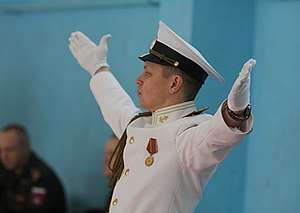
The repertoire of the military band service spans across hundreds of pieces, which included ceremonial and marching music. It also includes patriotic songs, such as the following music pieces:
| Title | Composer |
|---|---|
| Presidential Fanafare | Pavel Borisovich Ovsjannikov |
| National anthem of Russia | Alexander Vasilyevich Alexandrov |
| Moscow Fanfare | A. Golovin |
| Slavsya | Mikhail Glinka |
| The Sacred War | Alexander Vasilyevich Alexandrov |
| Adagio | Valery Khalilov |
| March of the Preobrazhensky Regiment | unknown |
| Farewell of Slavianka | Vasily Agapkin |
| Den Pobedy | David Tukhmanov |
| Song of the Soviet Army | Alexander Aleksandrov |
| Long Live our State | Boris Alexandrovich Alexandrov |
| March of the Artillerymen | Tikhon Khrennikov |
| Hero's March | |
| March of the Defenders of Moscow | Boris Mokrousov |
| Air March | Yuli Kant |
| Pervym delom samoljoty | Vasily Solovyov-Sedoi |
| Jubilee Slow March "25 Years of the Red Army" | Semyon Tchernetsky |
| March of the Tankists | Semyon Tchernetsky |
| Salute to Moscow | Semyon Tchernetsky |
| The Red Army's Entry into Bucharest | Semyon Tchernetsky |
| Cossacks in Berlin | Semyon Tchernetsky |
| Slow March of the Artillery | Semyon Tchernetsky |
| Slow March of the Tankists | Semyon Tchernetsky |
| In Defence of the Motherland | Viktor Runov |
| On Guard For Peace | Boris Diev |
| Phlanx March | Dmitry Pertsev |
| Slow March of the Red Army | Semyon Tchernetsky |
| Signal "Gathering!" | V. Pavlov |
| Signal "Changing of the Guard" | V. Pavlov |
| March "The Ship's bell | Valery Khalilov |
Some of these musical pieces (particularly the formal ones) are used elsewhere in the militaries of the Commonwealth of Independent States. Many famous melodies as Katyusha, Siny Platochek, and Podmoskovnye vechera have been converted into marches by certain military composers.[12]
List
Bands of military academies and educational institutions
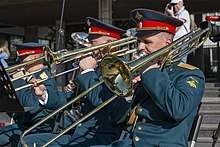
- Cadet Band of the Military Institute of Military Conductors
- Band of the Military University of the Ministry of Defense of the Russian Federation
- Training Band Wing of the Moscow Suvorov Military Music College Lieutenant-General VM Khalilov
- Youth Band of the Moscow Cadet Music Corps
- Band of the Combined Arms Academy of the Armed Forces of the Russian Federation
- Band of the Moscow Higher Military Command School
- Band of the Far Eastern Higher Combined Arms Command School
- Band of the N. G. Kuznetsov Naval Academy
- Band of the Peter the Great Military Academy of the Rocket Forces of Strategic Importance
- Band of the Moscow Border Institute of the FSB of the Russian Federation
- Band of the Ryazan Guards Higher Airborne Command School
- Band of the MES Civil Defense Academy
- Band of the Zhukovsky – Gagarin Air Force Academy Moscow Campus[13]
- Band of the A.V. Khrulyov Military Logistics Academy[14]
- Band of the Semyon Timoshenko Military University of Nuclear, Chemical and Biological Defense
- Band of the Budyonny Military Academy of the Signal Corps
- Band of the S.M. Kirov Military Medical Academy[15]
- Band of the Krasnodar Higher Military Aviation School[16]
Bands of Military Districts
- Military Band of the Western Military District in Saint Petersburg
- Military Band of the Southern Military District in Rostov-on-Don
- Military Band of the Central Military District in Ekaterinburg
- Military Band of the Eastern Military District in Khabarovsk
- Military Band of the Northern Fleet in Severomorsk
Bands of the Armed Forces
Russian Ground Forces
- Presidential Band of the Russian Federation - not directly under the RGF but under the direct control of the Kremlin Regiment, which reports to the Western Military District
- Special Exemplary Military Band of the Guard of Honor Battalion of Russia
- Band of the 154th Preobrazhensky Regiment
- Band of the 2nd Guards Tamanskaya Motor Rifle Division "Mikhail Kalinin"
- Band of the 4th Guards Kantemirovskaya Tank Division "Yuri Andropov"
- Band of the 25th Sevastopol Guards Motor Rifle Brigade
- Band of the 150th Rifle Division
- HQ Band of the 2nd Guards Army
- Band of the 27th Guards Motor Rifle Brigade[17]
- Band of the 45th High-Powered Artillery Brigade
- Band of the 1st Semyonovsky Independent Rifle Regiment
- Band of the 623rd Interspecific Regional Training Center for the Communications Troops[18]
- Engineering Troops Ensemble "For Faith and Fatherland"[19]
Russian Navy
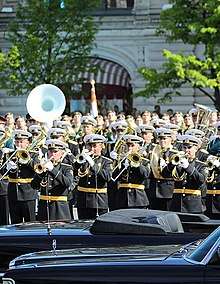
- Central Navy Band of Russia
- Admiralty Navy Band of Russia[20]
- Brass Band of the Novorossiysk Naval Base
- Brass Band of the Belomorskaya Naval Base
- Military Band of the Black Sea Fleet
- Military Band of the Baltic Fleet
- Military Band of the Pacific Fleet
- Military Band of the Caspian Flotilla
- Band of the 336th Guards Naval Infantry Brigade
- Band of the 810th Guards Naval Infantry Brigade
- Band of the 77th Naval Infantry Regiment
Russian Aerospace Forces
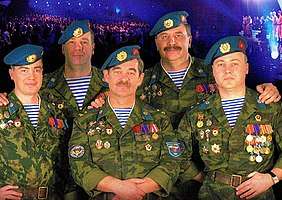
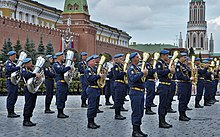
- Song and Dance Ensemble of the Russian Air Force[21][22]
- Concert Band of the Band of the 1st Aerospace and Missile Defence Forces Army
- Concert Band of the Band of the 6th Air and Air Defence Forces Army
- Concert Band of the Band of the 11th Air and Air Defence Forces Army
- Concert Band of the 14th Air and Air Defence Forces Army
- Concert Band of the 15th Aerospace Forces Army
- Central Band of the Russian Space Forces
- Brass Band of the Baikonur Cosmodrome of the Space Forces
- Band of the Main Testing Space Center
Other branches
- Strategic Missile Forces[23]
- HQ Band of the 33rd Guards Rocket Army
- Band of the 62nd Rocket Division
- Russian Airborne Forces
- Combined Band of the Russian Airborne Forces
- HQ Band of the 98th Guards Airborne Division
- HQ Band of the 106th Tula Guards Airborne Division
- Band of the 31st Guards Air Assault Brigade
- Blue Berets Band (not directly controlled by the military band service)
- HQ Band of the 7th Guards Air Assault (Mountain) Division
- Training Band of the 242nd Training Centre
- Band of the Guards Airborne Assault Caucasian Cossack Regiment
Overseas military bands
- Band of the Russian 201st Military Base
- Band of the Russian 102nd Military Base[24][25]
- Band of the 4th Guards Military Base
- Band of the 7th Military Base
- Band of the Operational Group of Russian Forces in Moldova
- Band of the Group of Russian Troops in Syria at Khmeimim Air Base
Bands of Russian Ministries and affiliate agencies
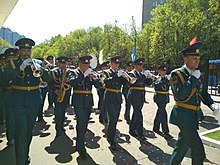

- Central Military Band of the Ministry of Defense of Russia (also known as the Red Army Band in the West)
- Band of the 147th Automobile Base of the Ministry of Defense[26][27]
- Girls Corps of Drums, Boarding School for Girls, Ministry of Defense of Russia
Not under the Armed Forces but under other agencies:
Former Bands
Under the Soviet Armed Forces and disbanded bands under the current Russian Armed Forces:
- Military Band Service of the Southern Group of Forces
- Military Band Service of the Group of Soviet Forces in Germany
- Military Band Service of the Central Group of Forces
- Military Band Service of the Northern Group of Forces
- Band of the Russian Transcaucasus Group of Forces
- HQ Band of the Far Eastern Military District[28]
- 11th HQ Band of the Turkestan Military District
- 14th HQ Band of the Kiev Military District
- 9th HQ Band of the Odessa Military District
- HQ Band of the Central Asian Military District
- Band of the Pushkin Air Defense Radioelectronical High School of the Soviet Air Defence Forces
- Band of the Donbass Pilot Training School
- Band of the Sevastopol College of Naval Engineering
- Band of the St. Peterburg Submarine Navigation High School
Under the Imperial Russian Army and the Imperial Russian Navy:
- Band of the Mozhansky Infantry Regiment
- HQ Band of the Imperial Life Guards and Petersburg Military District
- Band of the Preobrazhensky Life-Guard Regiment
- Band of the Semyonovsky Life Guard Regiment
- Band of the Pavlovsky Life-Guard Regiment
- Fanfare Band of His Imperial Majesty's Lifeguards Cossack Regiment
- Fanfare Section and Brass Band of His Imperial Majesty's Life Guard Horse Artillery Brigade
- Mounted Brass Band of the Life Guard Horse Regiment
- Band of the Alexander Military Institute
- Band of the Naval Cadet Corps Saint Petersburg
Musical Training
Musicians from the bands of the Moscow area garrison either receive their training from the Moscow Military Music College or the Moscow Conservatory.
After the 1917 October Revolution, the educational institutions of military bandmasters at conservatories in Petrograd and Moscow, as well as at the Warsaw Music Institute, were closed. In connection with the changing socio-political conditions and new ideological guidelines, a new system of musical education in the military was created. One of the first steps of the new Soviet government was the 1921 opening of classes at the Tashkent and Petrograd Military Music Schools. A year later, the Tashkent Military Music School was transferred to Petrograd and merged into the Petrograd Military Music School before being disbanded a year later. The remaining 30 students were transferred to the 8th Petrograd Infantry School. Due to the transfer of the school to Kiev, music conservatories became involved in the development of military music.[29] In 1932, a bandmaster class was organized at the Frunze Military Academy with a three-year term of study was established. By the mid-thirties, with the increase in the number of the Red Army, a large number of new military educational institutions, including military faculties at civilian educational institutions, had been created for the training and preparation of senior musical personnel. Among these faculties, the Military Department of the Moscow Conservatory on the basis of order No. 183 on 28 November 1935 was created. More institutions would be established in the 40s and 50s and advanced through the 60s and 70s.[29]
In October 1964, the first group of foreign students from the Mongolian People's Republic became enrolled in military musical institutions. In subsequent years, the number of students that came was expanded, with some coming form Bulgaria, the German Democratic Republic, Afghanistan, Burkina Faso, Yemen, Ethiopia and Vietnam. Since 1994, a special department had been operating at the Military Conducting Department, students of which come form countries of the Commonwealth of Independent States, with many graduates organizing military bands in their newly created home countries.[29]
Characteristics
Garrison Conductors
The military conductor of the massed city garrison bands is responsible for providing general garrison events with military bands of military units and for the preparation, training, administration and formation of massed garrison bands in their area of responsibility.
In addition, they are, according to Article 36 of a decree by the President of Russia, responsible for coordinating the musical accompaniement of military units without military bands and assist the commanders of these military units in the training of drummers and extra musicians. They also lead instruction classes with military conductors and senior military band personnel.[30] When on parade, they are usually referred to as the Chief Military Director (Главный военный дирижер) or Director of music as known in some Western countries. The Moscow area garrison massed bands are the country's seniormost massed bands formation, and its conductor holds the billet of Senior Director of Music of the Military Band Service.
The position of garrison conductor of massed military bands is present in many other Russian major cities.
Drum Majors
In the Russian military, drum majors (Russian: Тамбурмажор)[31][32][33][34][35] are commissioned officers who also serve as deputy band leaders and conductors. Although they are not required to be drummers, they but must have long experience as a military bandsman. The title was introduced in 1815 by the Imperial Russian Army. The Imperial uniform consisted of gold/silver galloons and a pair of epaulettes. The title was abolished in 1865 only for army regiments only to be reintroduced in the Red Army in 1918. The position was toned down following the Second World War, however the appointment of drum major was revived in the early-60s as style that could be differentiated with the Western version. All Russian drum majors are trained in military music schools and institutes like the Moscow Military Music College and the Institute of Military Band Conductors of the Military University of the Ministry of Defense. During parades, they carry maces with either their service or full dress uniform. The ceremonial maces they carry are held by their right hand and are thrusted up and down consistently to keep the band in step and on beat.
Fanfare trumpets
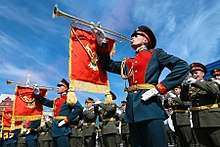
Fanfare trumpets in the military band service are an important part of state events and military band culture. Usually located at the front of a single band formation or in massed bands formation, the area of expertise of fanfare trumpeters in the armed forces includes playing specially composed fanfares such as the Moscow Fanfare or the Fanfare of the President of the Russian Federation. They were first seen in modern military parades in the 1920s, equipped with an elongated bell allowing for a flag or tabard to be hung. Most soldiers who were in the position of fanfare trumpeter were dressed in slightly different uniforms than the rest of the band, usually a different color of the full dress uniform. The natural chromatic fanfare trumpet model is used in many military bands in Russia, with similar ones also being used in military styled marching bands in Germany, France and the United Kingdom. During the Imperial period and up to the early decades of the Soviet Armed Forces these fanfare trumpets were kept as an important regalia for the unit, having the same status as a regimental colour, the first such instruments were granted as battle honours in 1737 and Guards Fanfare Trumpets with the Ribbon of St. George debuted for the Imperial Guard in 1805. When a unit band was disbanded, the fanfare trumpets were transferred to the Museum of the Red Army (now the Central Armed Forces Museum). In 1944, an order to revive the practice, this time for distinguished service in the Red Army, failed to pass in the Presidum of the Supreme Soviet, but nevertheless the fanfare trumpets were given to outstanding bands of units for service to the homeland in times of war. In the ground forces and air force bands the fanfare trumpets, then as is now, have scarlet tabbards with the symbol of the Band Service on them in gold at the center and is surrounded with gold fringe, the symbol is that of two crossed natural chromatic fanfare trumpets with a lyre, symbol of military music, at the center.[36] In the naval bands, the tabard, gold fringed, is in the form of a small version of the state naval ensign.
Field snare drummers of massed bands
The late decades of Soviet rule also saw the reintroduction of another aspect of military bands in Russia: the field snare drummers, which are a modern form of the days wherein snare drummers lead out their bands or their respective units on parade (the latter when with buglers, fifers and/or fanfare trumpeters) or when in massed bands formation. They first appeared during the October Revolution Day parade of 1981, and the Special Exemplary Military Band of the Guard of Honor Battalion of Russia pioneered the use of the drums when they first adopted them for state arrival and wreath laying ceremonies in 1978-1979. These drummers typically carry large or small sized side marching snare drums fitted with rubber or cotton slings, during the 1980s the drums were painted red and white with the red star cap badge of the Soviet Armed Forces in the center and gold borders. Today, of all select cities that have had massed bands formation for major parades during the 1980s, only 5 now maintain the practice for major national holidays (Moscow, Krasnodar, Sevastopol (introduced 2018), Yekaterinburg (reinstated 2020) and Khabarovsk (introduced 2017)), formerly it was standard use in the massed bands in St. Petersburg, Kazan and Rostov-on-Don, among other cities. In Moscow, the field snare drummers of the massed bands today wear the same uniforms as the fanfare trumpeters to honor their Imperial predecessors.
Corps of Drums
Most military academies and cadet schools, as well as a number of HQ and support units of military formations and commands, maintain a corps of drums (known locally as rota barabanshchiki) that are specifically brought out during military parades. These formations too are of Imperial origin. Corps of drums are always made a separate part of military bands and are usually led by a drum major in the place of the director of music of a certain band and are the first formation to march past the saluting grandstand in parades, with its drummers first sounding a drumbeat cadence that keeps the parade on the beat before they march past. If possible, the corps of drums of the local Suvorov or Nakhimov Naval School would be used during events of national importance. The most famous of these special units in the international sphere would be the Corps of Drums of the Valery Khalilov Moscow Military Music College, first unveiled during the Moscow Victory Parade of 1945 and has since been regular participant in the October Revolution Day (1938 to 1990), May Day (1938 to 1968) and Victory Day (1965, 1985, 1990, 1995–2008, 2012-)[37] parades on Red Square. A Turkish crescent for the college was used as its unit symbol during the Soviet era until it was replaced in 1995 by a colour guard squad. Most of these corps have an instrumentation that includes snare drums, fifes, trumpets, glockenspiels and on occasion, chromatic fanfare trumpets and trombones, and its musicians wear the service or full dress uniform of their respective unit or educational institution. Until 1969 the corps of drums, following its march past in front of the parade grandstand, would be positioned near the massed bands to provide additional support in parades. It has been resumed only in Moscow beginning in 2010, but only on Victory Day during the mobile column segment.
Uniform

The uniforms of Russian military bands vary depending on the unit. Most unit bands utilize the standard dress uniform with the closed collar of the Russian Army (updated in 2017), although the everyday service uniform can also be worn. The Exemplary Band of the Honor Guard has from 1958-1971 and since 2013 worn the full dress uniform of the 3rd Honor Guard Battalion, 154th Preobrazhensky Independent Commandant's Regiment (known in the Soviet era as the M-1955), which consists of a closed collar uniform with a red plastron with golden piping. From 1971-2013, the band wore the standard dress uniform of the armed forces.[38] The Central band of the defence ministry wears uniforms similar to the Imperial-style uniforms of the Kremlin Regiment. The Presidential Band performs in all white dress uniforms with blue epaulettes on the sides. The Central Navy Band and all Navy bands wear standard naval uniforms, including those of the Naval Infantry, which wear their signature black berets.
Size and composition
There are 4 variant sizes of military bands. The size depends on the status of the unit/institution of which it is attached. For example, a band of a regiment/brigade formation may only have 18 people (they are usually referred to as полковом оркестре, meaning regimental bands), whereas a band of a military academies may have 26 people. Bands of district of headquarters and fleets have 44 people, recruiting personnel from all over their area of responsibility. The largest ones are the bands of service branches and specialized units called Exemplary Bands, numbering around 63 people each. Most military bands are filled with a variety of different types of soldier, whether it be conscripts, cadets or recently civilian musicians.[2]
Performances
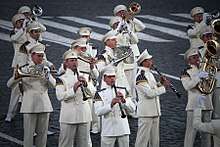
- The combined bands of the Moscow Garrison (usually composed of over 1,100 musicians) are required to take part in the annual Moscow Victory Day Parade on Red Square under the leadership of the Senior Director of Music of the Military Band Service of the Armed Forces of Russia.
- The Central Military Band of the Ministry of Defense of Russia is also required to take part in the Russian Honor Parade on Red Square on November 7.
- The Special Exemplary Military Band of the Guard of Honor Battalion of Russia performs with the 154th Preobrazhensky Independent Commandant's Regiment during the welcoming of foreign delegations to Russia.
- Being the host of the festival, the senior director of music of the military band service requires Russian military bands to take part in the Spasskaya Tower military tattoo. He serves as the lead co-organizing chairman of the festival and its executive producer.
Notable current and former musicians in the Russian/Soviet Armed Forces
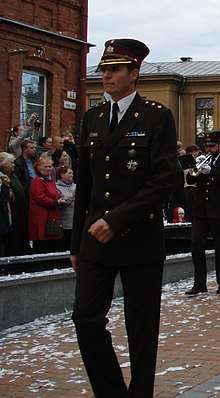
- Lieutenant General Valery Khalilov – Considered to be the last great conductor to be educated in the Soviet era, he was notable for his policy of promoting Russian military bands on the world stage and his reorganization of the military band service and the massed bands of the Moscow Garrison.
- Captain Alexei Karabanov – Current conductor of the Central Navy Band of Russia and longtime director of the Admiralty Navy Band of Russia from 1985-2008.
- Vasily Agapkin - composer and author of Farewell of Slavianka (written 1912)
- Colonel Armen Poghosyan – Current Director of the Band of the General Staff of the Armed Forces of Armenia
- Colonel Alexander Gerasimov – Director of the Moscow Military Music College
- Colonel Dainis Vuskans – Current Director of the Latvian NAF Staff band and former member of the Band of the Kaliningrad Garrison
- Colonel Pavel Makarov – Current Director of the Band of the Ministry of Defense of the Republic of Uzbekistan and former commander of the 11th Band of the Turkestan Military District
- Major General Volodymyr Derkach – Senior Military Director of the Military Music Department of the General Staff of the Ukrainian Armed Forces from 1995 to 2014
- Major General Yusif Akhundzade – Director of the Central Band of the Ministry of Defense of Azerbaijan since 1992.
- Lieutenant Colonel Yunus Gulzarov – Former director of the Uzbek Ministry of Internal Affairs and former member of the Band of the Soviet Defence Ministry.[39]
- Ilya Shatrov - Former bandmaster of the Mokshansky Regimental Orchestra
- Vladimir Mikhailov - Press Secretary for the Central Band of the Russian Defence Ministry[40]
- Viktor Runov - Notable Russian military composer and former director of various bands in the Moscow area, including the Band of the Moscow Border Guard School of the Soviet Interior Ministry[41]
- Yuri Griboyedov
- Dmitry Pertsev - Director of the Military Band of the Leningrad Military District in the 1970s
- Igor Lifanovsky, Russian French horn player and former member of the Band of the Kiev Military District[42]
- Alexander Salik - Director of the Military Band Service of the Northern Group of Forces from 1979 to 1984 and director of the Military Band Service of the Odessa Military District from 1984 to 1990.
- Stanislav Volynov - Director of the Military Band Service of the Northern Group of Forces from 1984 to 1988.[43]
- Georgy Petrovich Alyavdin - Director of the Central Navy Band of Russia from 1953-1970 and professor of music who's pupils included Valery Khalilov and Captain Alexei Karabanov.
- Michael Yaaran - Director of the Israel Defense Forces Orchestra from 2003 to 2013.
Gallery
Photo
 The combined Navy Band of Russia.
The combined Navy Band of Russia.
 The HQ Band of the Northwestern District Command of the National Guard
The HQ Band of the Northwestern District Command of the National Guard
 The Military Band of the Baltic Fleet
The Military Band of the Baltic Fleet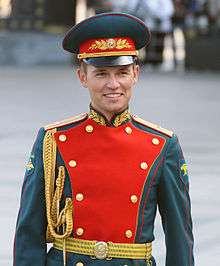 Konstantin Petrovich
Konstantin Petrovich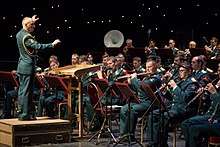 The central band under the direction of Colonel Sergey Durygin during its 90th anniversary concert in 2017.
The central band under the direction of Colonel Sergey Durygin during its 90th anniversary concert in 2017.- The military band of the 79th Guards Motorized Rifle Regiment.
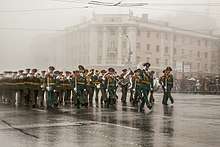 The Massed Bands of the Nizhny Novgorod Garrison.
The Massed Bands of the Nizhny Novgorod Garrison. The Band of the Volgograd Garrison.
The Band of the Volgograd Garrison.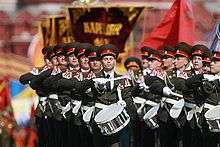 The corps of drums of the Moscow Military Conservatoire during the Victory Parade on Red Square in May 2010.
The corps of drums of the Moscow Military Conservatoire during the Victory Parade on Red Square in May 2010. A band of an airborne cossack regiment.
A band of an airborne cossack regiment. Members of an air force band on Air Force Day in 2020.
Members of an air force band on Air Force Day in 2020.
Videos
See also
- Military Band Service of the Armed Forces of Russia
- Military band
- Corps of drums
- Fanfare band
- Canadian military bands
- United States military bands
- List of marching bands
- March (music)
| Wikimedia Commons has media related to Military bands of Russia. |
References
- https://www.latimes.com/archives/la-xpm-2005-may-09-fg-bands9-story.html?_amp=true
- https://echo.msk.ru/amp/programs/voensovet/1380494-echo/
- http://old.redstar.ru/2009/04/15_04/3_02.html
- "Военно-оркестровая служба Вооруженных Сил Российской Федерации : Министерство обороны Российской Федерации". structure.mil.ru. Retrieved 2017-04-29.
- https://orkestrov.net/istoriya_voennogo_orkestra
- Zetlin, 195–96.
- Abraham, New Grove (1980), 16:29.
- http://stores.militaryhistoryshop.com/blog/military-music-and-tradition-in-imperial-russia/
- https://pikabu.ru/story/muzyika_velikoy_otechestvennoy_kak_voevali_voennyie_orkestryi_krasnoy_armii_7216060?view=amp
- https://cyberleninka.ru/article/n/organizatsionnye-osnovy-razvitiya-voenno-orkestrovoy-sluzhby-vooruzhennyh-sil-sssr-v-1946-1991-gg
- https://m.youtube.com/watch?v=N-AugHy52Wc
- eng.mil.ru http://eng.mil.ru/en/news_page/country/more.htm?id=12030235@egNews. Retrieved 2020-07-16. Missing or empty
|title=(help) - https://kazan-kremlin.ru/fan_user2019/orkestr-filiala-voennogo-uchebno-nauchnogo-tsentra-voenno-vozdushnyh-sil-voenno-vozdushnaya-akademiya-imeni-professora-n-e-zhukovskogo-i-yu-a-gagarina-g-chelyabinsk-2/
- http://vamto.net/about_university/departments-and-services/voennyy-orkestr/
- https://www.vmeda.org/orkestr-voenno-medicinskoj-akademii-luchshij-v-vooruzhennyx-silax-rossijskoj-federacii/
- http://www.partita.ru/orchestras/krasnodar.shtml
- https://spasstower.ru/participants/orkestr-27-y-otdelnoy-gvardeyskoy-motostrelkovoy-brigady/
- https://kazan-kremlin.ru/fan_user2019/svodnyj-orkestr-ulyanovskogo-garnizona-2/
- Хору инженерных войск «За Веру и Отечество» исполнилось 25 лет / mil.ru, 23.01.2018
- "The Admiralty Navy Band of Russia - History". 2012-01-01. Archived from the original on 2012-01-01. Retrieved 2017-12-19.CS1 maint: BOT: original-url status unknown (link)
- "Ансамбль песни и пляски ВКС РФ | Москва | ВВС | ПВО |". Ансамбль ВКС РФ (in Russian). Retrieved 2020-08-05.
- https://milcult.ru/ansambl-pesni-i-plyaski-voysk-vozdushno-kosmicheskoy-oborony
- "РВСН". milkavkaz.com. Retrieved 2020-08-04.
- https://function.mil.ru/news_page/country/more.htm?id=11026367@egNews
- https://newsarmenia.am/news/politics/defence-20120402-42636752/?__cf_chl_jschl_tk__=e6a41b1d3e45f18c99ab039e1393fa4d068b0aeb-1595458370-0-AXwuaougLGhCJoiHEph2Lv6UQ31tJMJpR2YvsAMUK_cuBFb5aswDirxaoC3DQR2olMPZY07nm_6eMr2v0G1ea0rYLvn_7uHCXKznwlgi_b4oBpoirvFXyHQaBuynzqbiZTy8kNyxK_zjPtGBx6EvPj0AONwe3rJ9pj3_CPtC2ahIyE0fGzYXI28u9aoQnAZ3uD3i7-4VS8BHAHcaUZ9Wg1i1NeLQwzuKDp_yVydGsRkwbaPG4o2Z1qoB020lmbAEAGLPq7SDz3kz_oVxxxXVGjAbAlSsiGiJ3dte2UDsBZOPyUqo4HNn6AKUY2JSNrZdtqkpcUo40KQenn1WOLi8TH8
- http://mil.ru/147ab/subunits/orchestra.htm
- https://spasstower.ru/participants/orkestr-147-avtomobilnoy-bazy-ministerstva-oborony/
- Военной музыки оркестр
- http://www.art-education.ru/electronic-journal/voenno-muzykalnoe-obrazovanie-v-sssr-kratkiy-istoriko-pedagogicheskiy-ocherk
- http://www.consultant.ru/document/cons_doc_LAW_72806/95dd9a938471f15c853b2c14bd5b79eba04efa56/
- Иванова О. Е., Лопатин В. В., Нечаева И. В., Чельцова Л. К. Русский орфографический словарь : около 200 000 слов / Отв. ред. В. В. Лопатин, О. Е. Иванова. — 4-е изд., испр. и доп. — М.: АСТ-ПРЕСС КНИГА, 2015. — С. 737. — 896 с. — (Фундаментальные словари русского языка). — 3000 экз. — ISBN 978-5-462-01272-3.
- Букчина Б. З., Сазонова И. К., Чельцова Л. К. Орфографический словарь русского языка / Отв. ред. И. Сазонова. — 6-е изд. — М.: АСТ-ПРЕСС КНИГА, 2010. — С. 1084. — 1296 с. — (Настольные словари русского языка). — 3000 экз. — ISBN 978-5-462-00736-1.
- Бешенкова Е. В., Иванова О. Е., Чельцова Л. К. Объяснительный русский орфографический словарь-справочник / Отв. ред. Е. В. Бешенкова. — М.: АСТ-ПРЕСС КНИГА, 2015. — С. 425. — 592 с. — (Настольные словари русского языка). — 1500 экз. — ISBN 978-5-462-01418-5.
- Соловьев Н. В. Орфографический словарь русского языка : ок. 130 000 слов : ок. 400 коммент. — М.: АСТ: Астрель: Хранитель, 2008. — С. 858. — 1005, [3] с. — (Словари Академии Российской). — 3000 экз. — ISBN 978-5-17-018549-8.
- Розенталь Д. Э. Большой справочник по русскому языку: Орфография. Пунктуация. Орфографический словарь. Прописная или строчная? / Отв. ред. С. О. Савчук. — М.: Оникс, 2011. — С. 948. — 1008 с. — 5100 экз. — ISBN 978-5488-02204-1.
- http://marksrussianmilitaryhistory.info/Fanfare.htm
- https://www.vesti.ru/doc.html?id=2566263
- http://www.undertheredstar.com/honor.htm
- http://orkestr-uz.narod.ru/dirijeri/gulsarov/gulsarov.htm
- https://life.ru/t/%D0%B7%D0%B2%D1%83%D0%BA/549051
- https://dic.academic.ru/dic.nsf/enc_biography/108326/%D0%A0%D1%83%D0%BD%D0%BE%D0%B2
- https://www.classicalmusicnews.ru/reports/igor-lifanovsky-80-concert/
- http://odma.edu.ua/rus/structure/faculties/orchestral_faculty/orchestral_string_instruments_and_opera_and_symphony_conducting/volinov
Video sources
- "Central Military Band of Russia Documentary Фильм о Военном Оркестре России". Youtube (in Russian). Retrieved 2018-07-13.
- Военно-оркестровая служба Вооруженных Сил Российской Федерации. Mil.ru (in Russian). Retrieved 2018-07-13.
- "March of Life Guards Preobrazhensky regiment". Youtube. Retrieved 2018-08-06.
- Военный оркестр вч 80847 ГСВГ. Youtube (in Russian). Retrieved 2018-10-14.
- قيادة الفرق الموسيقية العسكرية بعصى القيادة. Youtube (in Arabic). Retrieved 2018-11-27.
- "Massed Bands of the Soviet Army plays march "The Stars and Stripes Forever" by Sousa". Youtube. Retrieved 2019-09-19.
- "Сводный оркестр Санкт-Петербургского гарнизона исполняет военные марши". Youtube. Retrieved 2019-09-20.
- "Музыкальное оформление воинских ритуалов. МО СССР 1982 год". Youtube. Retrieved 2019-10-09.
